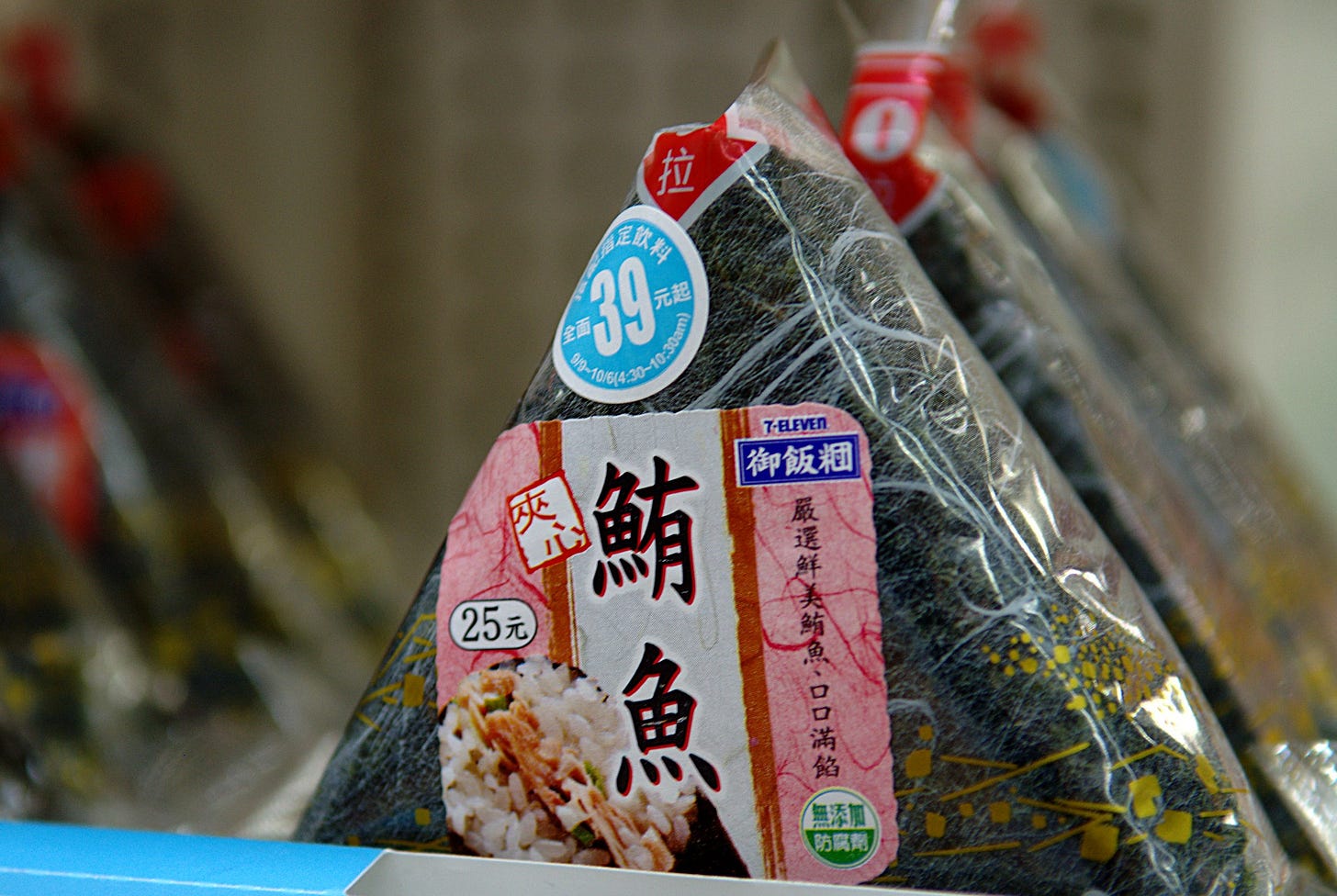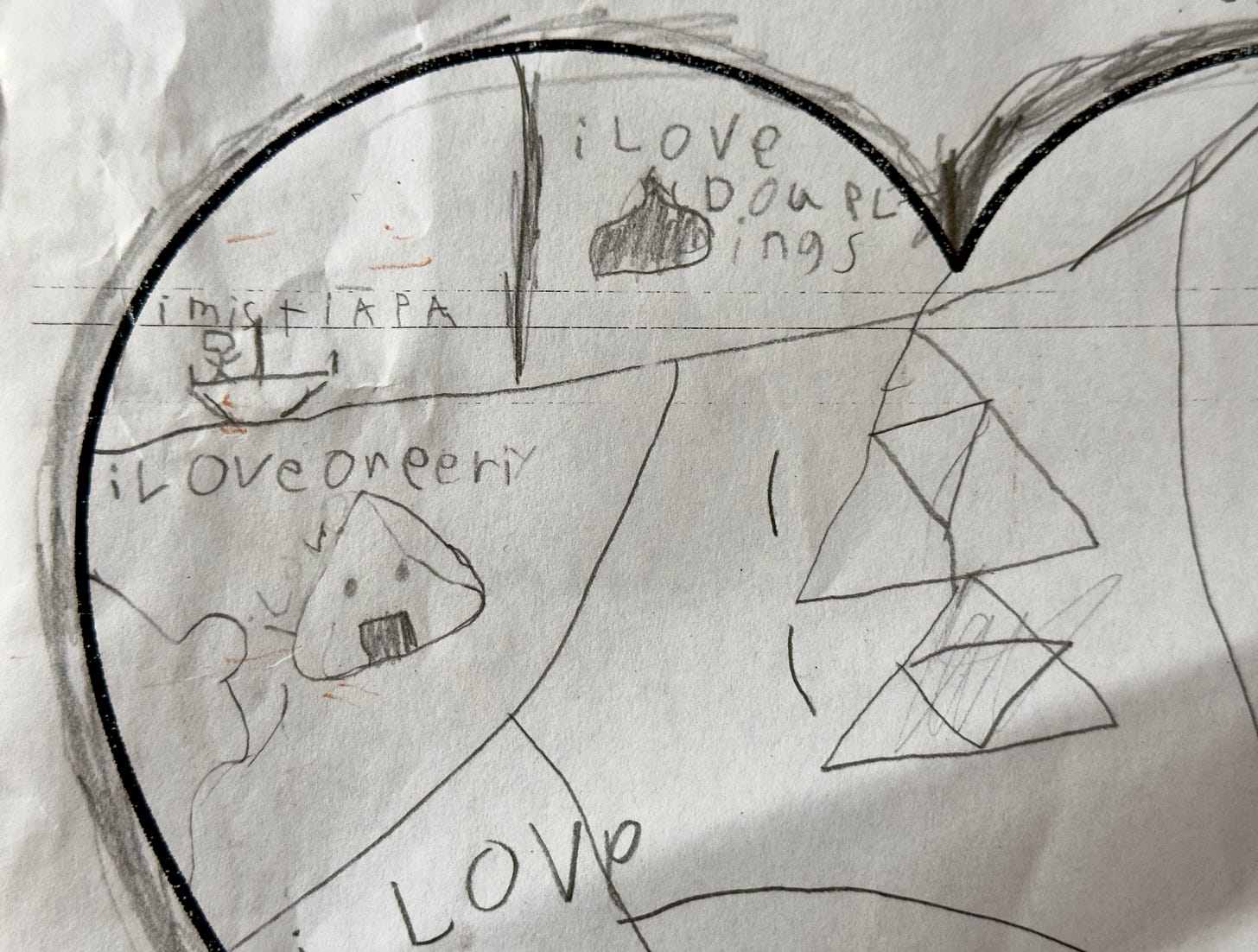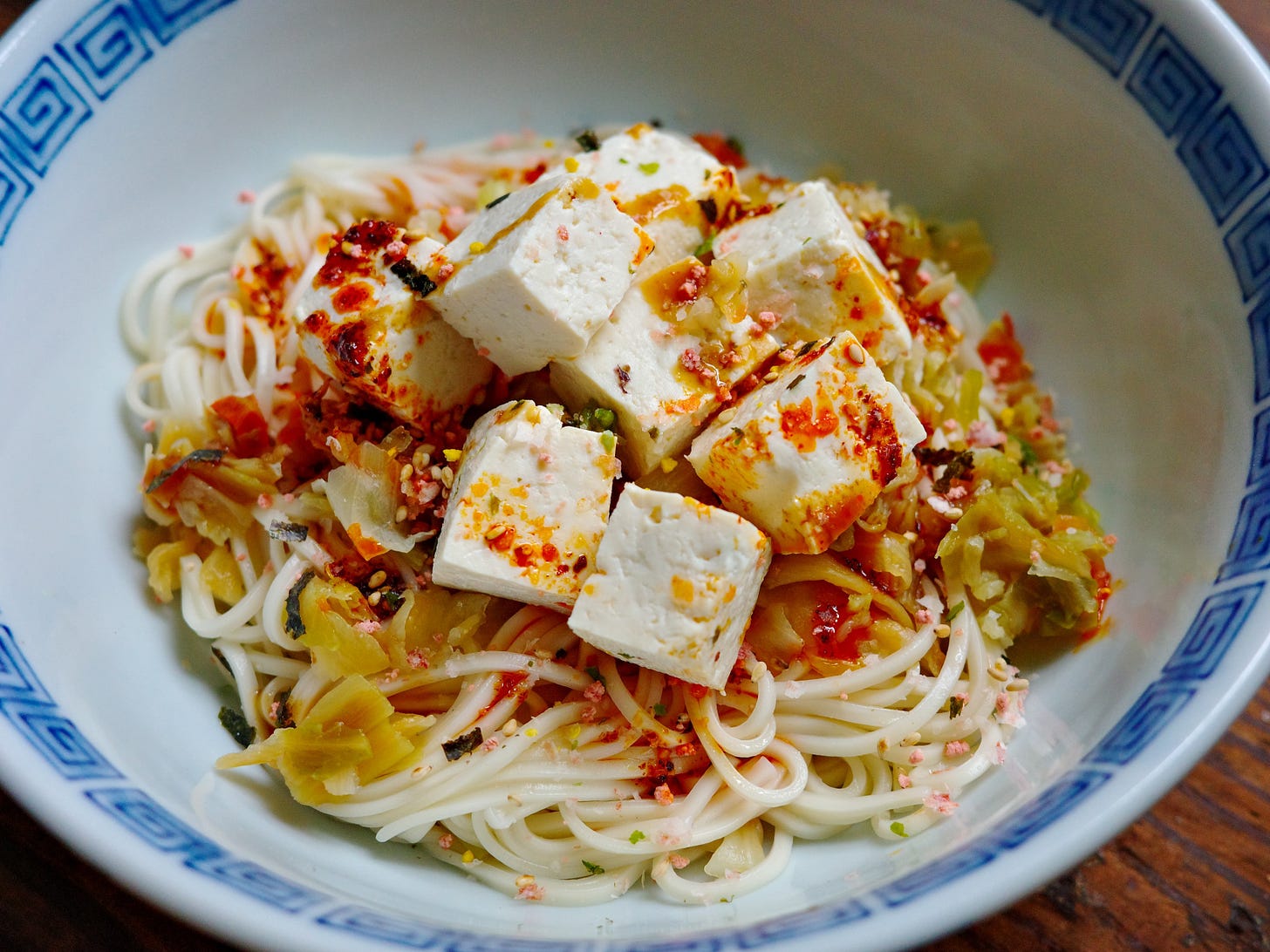This is Yun Hai Taiwan Stories, a newsletter about Taiwanese food and culture by Lisa Cheng Smith 鄭衍莉, founder of Yun Hai. If you aren’t yet a subscriber, sign up here.
We bought too much dried fruit so we’re putting it on sale while supplies last—a rare affair. The best deals are on 12-pack cases of green mango and pearl guava (eat your greens, as it were), but all are kissed by a promo.
This week, we’re launching a long time favorite: high mountain dried cabbage. Don’t underestimate this humble Brassica: it’s colorful, it’s peppery, and (like many of the best things about Taiwan) it’s incredibly convenient. The cabbage comes from Pear Mountain (Lishan 梨山), where crops are raised on spring water and mountain air. Gently dehydrated and seasoned, this dried veggie mix preserves the flavor and color of the original. The little pieces are gorgeous; I can’t believe how big they get after a hot soak. Read on for recipes.
We’re in back-to-school mode, which means the return of predictable childcare, but also the open-ended question of school lunch. School mandates: no nuts, no chips, no candy (good), no popcorn (wth). Mix this with our children’s aversions to baby carrots, dry pretzels (I get it), unrefrigerated cut fruit, and anything but cheese in their sandwiches and we’re a little low on convenient but healthy options.

There’s one thing they do love, though. Onigiri, or Japanese-style sticky rice balls 飯糰, which they gobbled up in 7-11’s throughout Taiwan during last year’s family vacation. They love them so much, my older son draws them on school assignments alongside little notes that say I miss Taipei. They beg me to make them for lunch. And I do, every morning, at 6 am. Overindulgence? Good model parenting? I’ll never know.
Onigiri, if you’ve never had them, are hand-molded rice balls that can be packed with protein-rich fillings and wrapped with seaweed, aka a Calorie Delivery System. You can mix in healthy grains (I like to add quinoa), fill them with leftover salmon from last night’s dinner, or roll them in sesame seeds for a little extra nutrition. One thing I’ve always struggled to figure out, though, is how to add vegetables, which are just too large (and full of water) to work well in this small format.
Cue High Mountain Dried Cabbage, a product I’ve been experimenting with (and that we’re launching today). The best way to describe it: imagine if the freeze-dried vegetables in your instant ramen were actually really good. I wondered if I could cook these together with the rice and make a sort of veggie terrazzo.

I threw a couple of handfuls of dried veggies into my Tatung rice cooker before getting it started. Then, I added some extra water (about half the volume of the handfuls) and went for it. It worked perfectly: the rice came out sticky and chewy, as normal, but topped with a smattering of cabbage and carrot. Beautiful.
(For Tatung users, my formula was a half rice cup of cabbage mix for three cups of rice. I put 3.25 cups of water into the inner pot, and one cup in the outer pot.)
I gave the rice a good mix and used this to form the onigiri, with the veggies incorporated throughout. The extra vegetables posed no problem for rice adherence, and the Taiwan terrazzo look came through.
The rice was still mild in flavor (would the kids even notice), but the occasional bite of carrot or cabbage was so good with the pork floss and kewpie mayo I put inside. It added a whole new dimension, as vegetables do.
The dried cabbage was perfect for this. Because it was already cut into fairly small pieces and added no additional hydration, it was easy to incorporate into the grains. I made it for the first time today and was so pleased to see no leftovers in their lunchboxes at the end of the day.
High Mountain Cabbage
When I think of Asian vegetables, napa cabbage 白菜 comes to mind as the top of the Asian cabbage food chain, but in Taiwan, round cabbage 高麗菜 is king; it’s the most widely consumed vegetable in the country. And, in terms of worldwide cabbage consumption, Taiwan is second.
Next time you’re there, look around for it. You’ll see that Taiwanese style kimchi, or pao cai 泡菜, is made with regular cabbage instead of napa cabbage. You’ll find the veggie on the menu almost everywhere, and at wet markets, you’ll see multiple kinds piled high. Smile Taiwan describes cabbage as the TSMC semiconductor of the vegetable world: when the price for cabbage changes, so too does the price for all the other veggies, in step.

Cabbage is a cruciferous vegetable, and is better conditioned to the cooler climate of the mountains, where they grow to be sweeter and crisper than their flatland cousins, embodying that je ne sais quoi of mountain air. Lishan 梨山 is a mountainous area known for its scenic landscapes, apples, pears, and also its vegetables. The cabbage grown there is raised on mountain spring water, and is so good it brings tourists.
High Mountain Cabbage Mix
Because we can’t (yet) ship you Lishan cabbage straight off the field, we’ve worked with a Yunlin-based vegetable co-op to bring in this dried version from the same region. Throw a handful into your KiKi noodles (available at our Brooklyn store) on the stove, or make a quick cabbage sipping broth that will comfort you on a crisp, wintery morning (or a hot summer’s day, if mom has her way).

This magical mix of high mountain cabbage and carrot has been flying under-the-radar in our shop since we opened the brick-and-mortar two years ago. It’s been a staple in Lillian’s kitchen for more than a decade as a low-cost, quick, and healthy meal hack.
Here’s her method for a Taiwanese-style dry noodle 乾麵 complete with veggies and protein: boil noodles, drop tofu and dried cabbage into the water as they boil, strain and place into a bowl, and mix in soy sauce, sesame oil, and chili crisp (if you’re the spicy type). I used Su Mala Chili Crisp and some random togarashi I had kicking around.
Lillian used to carry this dried cabbage back from Taiwan to restock her pantry, and stocked it at our shop so she’d never run out. A true staff favorite.
Our store manager, Natya, came up with a recipe for a cabbage sipping broth that customers could sample. The dish was devised to raise the visibility of the humble bag of cabbage on the lower shelf, but it backfired and we sold out to all our brand new dried cabbage regulars. Ironically, Lillian has had to carry back more dried cabbage from Taiwan than she probably did her entire pre-Yun Hai lifetime.
Instead of sending her back to Taiwan with three empty suitcases, we’re just shipping it over by boat now. It’s online as of today.
High Mountain Cabbage Soup Bundle
The sweet flavors of the cabbage and carrot combine to make an exceptionally delicious veggie broth. We’ve put together a bundle with all our favorite stock ingredients that can be mixed and matched into a light and healthy cabbage soup. It’s got dried old radish (king of the hill when it comes to stock starters imho); organic log-grown shiitake mushrooms; the cabbage mix itself, and dunaliella algae salt, made naturally in Taiwan’s solar salt fields.

My recipe for cabbage soup or stock:
First, collect 1 piece of aged daikon, 3/4 cup of high mountain cabbage mix, and two shiitake mushrooms. Arrange on a plate into a smiley face. Show no one but enjoy your agency as a free thinking adult.
Drop your new friend into 12 cups of water in a stockpot or the inner pot of a Tatung steamer. Continue to enjoy the joke.
Simmer for 45 minutes to an hour, or steam in the Tatung for 25.
Open the lid and marvel.
At this point you can strain the broth and freeze it as veggie stock for future endeavors. Or, proceed to soup.
Remove mushrooms, cut off tough stems, and slice thinly.
Ladle into a bowl, add a few mushroom slices, and sprinkle dunaliella salt to taste. For a heartier meal, add cooked noodles (wheat, rice, or vermicelli would all work).
Garnish with a drizzle of black sesame oil if you have it and chopped green onion.
Drink the rainbow.
Yes, Taiwanese Dried Fruit is on Sale
Our Taiwanese dried fruit is my favorite anywhere snack—I keep it in the car, in my bag, and throw a few pieces into my kids’ lunches (better than candy imho).
Because of this enthusiasm, we bought a little too much for the fall season and need to clear space for the next batch coming in. This is perfectly timed to the back-to-school/back-to-work season, and I hope select slivers of green mango or pearl guava make it into school and work lunches everywhere.
Dried green mango and pearl guava are the best values, and are up to 20% off on cases. The rest of our fruits are on sale too, with up to 10% off on dried Irwin Mango, Golden Diamond Pineapple, Wax Apple, gift boxes, and our all-fruit samplers.
Note that the best-by date for the dried green mango is coming up in November. This is not an expiration date and they do stay good past that!
We started this line in response to fruit bans imposed on Taiwan by China, which left farmers at risk. When pineapple was banned by China in 2021, we collected dried fruit preorders via Kickstarter and were able to purchase over 14 tons of fruit from Taiwan.
We’ve never looked back. Through this line, we’ve cultivated important relationships with a handful of amazing fruit farmers, who grow and dry the fruit you see pictured here. It really is the best you can get.
I miss Tiapai, I love douplings, I love oneeri,
Lisa Cheng Smith 鄭衍莉
Written with editorial support by Amalissa Uytingco, Jasmine Huang, and Lillian Lin. If you enjoyed this newsletter, please share it with friends and subscribe if you haven’t already. I email once a month, sometimes more, sometimes less. For more Taiwanese food, head to yunhai.shop, follow us on instagram and twitter, or view the newsletter archives.
What's On at Yun Hai
This is a mostly up-to-date list of limited time discounts, product launches, and special events at Yun Hai. Find us online at yunhai.shop and in person at the Yun Hai Taiwanese General Store in Williamsburg, Brooklyn.
黑金: Old Radish Soup, an Allegory
This is Yun Hai Taiwan Stories, a newsletter about Taiwanese food culture by Lisa Cheng Smith 鄭衍莉, founder of Yun Hai Taiwanese Pantry. If you aren’t yet a subscriber, sign up here.
高山菇: High as a High Mountain Mushroom
This is Yun Hai Taiwan Stories, a newsletter about Taiwanese food culture by Lisa Cheng Smith 鄭衍莉, founder of Yun Hai Taiwanese Pantry. If you aren’t yet a subscriber, sign up here.






















Ahhhh. My mother called to warn me yesterday about our Saturday dinner, that she didn’t buy 高麗菜 in Manhattan Chinatown yesterday because it was too heavy. She said she and another woman stood contemplating them but each was too massive for their elderly arms to handle. My loss!
Your onigiri are making me nostalgic for the pork floss and egg sandwiches my mom put in my lunch box as a kid.
still giggling about Ted 😂😂😂 loved this post!